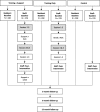A randomized controlled trial to evaluate the effectiveness of a staff training program to implement consumer directed care on resident quality of life in residential aged care
- PMID: 30470201
- PMCID: PMC6251149
- DOI: 10.1186/s12877-018-0966-1
A randomized controlled trial to evaluate the effectiveness of a staff training program to implement consumer directed care on resident quality of life in residential aged care
Abstract
Background: Residential Aged Care Facilities (RACFs) are moving towards a Consumer Directed Care (CDC) model of care. There are limited examples of CDC in ageing research, and no evaluation of a comprehensive CDC intervention in residential care was located. This study will implement and evaluate a staff training program, Resident at the Center of Care (RCC), designed to facilitate and drive CDC in residential care.
Methods: The study will adopt a cluster randomized controlled design with 39 facilities randomly allocated to one of three conditions: delivery of the RCC program plus additional organizational support, delivery of the program without additional support, and care as usual. A total of 834 staff (22 in each facility, half senior, half general staff) as well as 744 residents (20 in each facility) will be recruited to participate in the study. The RCC program comprises five sessions spread over nine weeks: Session 1 clarifies CDC principles; Sessions 2 to 5 focus on skills to build and maintain working relationships with residents, as well as identifying organizational barriers and facilitators regarding the implementation of CDC. The primary outcome measure is resident quality of life. Secondary outcome measures are resident measures of choice and control, the working relationship between resident and staff; staff reports of transformational leadership, job satisfaction, intention to quit, experience of CDC, work role stress, organizational climate, and organizational readiness for change. All measures will be completed at four time points: pre-intervention, 3-months, 6-months, and 12-month follow-up. Primary analyses will be conducted on an intention to treat basis. Outcomes for the three conditions will be compared with multilevel linear regression modelling.
Discussion: The RCC program is designed to improve the knowledge and skills of staff and encourage transformational leadership and organizational change that supports implementation of CDC. The overarching goal is to improve the quality of life and care of older people living in residential care.
Trial registration: ACTRN12618000779279; Registered 9 May 2018 with the Australian and New Zealand Clinical Trials Registry (ANZCTR; http://www.anzctr.org.au/ ).
Keywords: Consumer directed care; Resident choice and control; Resident quality of life; Residential aged care; Staff training.
Conflict of interest statement
Ethics approval and consent to participate
This project has been approved by Swinburne University of Technology’s Human Research Ethics Committee (SHR Project 2018/070). All participating aged care staff and aged care residents will be provided with a plain language statement and will be asked to provide written informed consent to participate.
Consent for publication
Not applicable.
Competing interests
The authors declare that they have no competing interests.
Publisher’s Note
Springer Nature remains neutral with regard to jurisdictional claims in published maps and institutional affiliations.
Figures
Similar articles
-
Consumer directed care in residential aged care: an evaluation of a staff training program.Aging Ment Health. 2020 Apr;24(4):673-678. doi: 10.1080/13607863.2019.1574711. Epub 2019 Feb 21. Aging Ment Health. 2020. PMID: 30789027
-
Effectiveness of professional oral health care intervention on the oral health of residents with dementia in residential aged care facilities: a systematic review protocol.JBI Database System Rev Implement Rep. 2015 Oct;13(10):110-22. doi: 10.11124/jbisrir-2015-2330. JBI Database System Rev Implement Rep. 2015. PMID: 26571287
-
Feasibility of LifeFul, a relationship and reablement-focused culture change program in residential aged care.BMC Geriatr. 2018 May 31;18(1):129. doi: 10.1186/s12877-018-0822-3. BMC Geriatr. 2018. PMID: 29855345 Free PMC article.
-
Leadership and registered nurses (RNs) working after-hours in Residential Aged Care Facilities (RACFs): A structured literature review.J Clin Nurs. 2018 Nov;27(21-22):3872-3881. doi: 10.1111/jocn.14565. Epub 2018 Jul 24. J Clin Nurs. 2018. PMID: 29893469 Review.
-
Do interventions with staff in long-term residential facilities improve quality of care or quality for life people with dementia? A systematic review of the evidence.Int Psychogeriatr. 2016 Dec;28(12):1937-1963. doi: 10.1017/S1041610216001083. Epub 2016 Jul 21. Int Psychogeriatr. 2016. PMID: 27439660
Cited by
-
Benefits, Challenges and Solutions for Implementing Personalised Music Playlist Programs in Residential Aged Care in Australia.J Multidiscip Healthc. 2021 May 25;14:1193-1204. doi: 10.2147/JMDH.S293764. eCollection 2021. J Multidiscip Healthc. 2021. PMID: 34079277 Free PMC article.
-
Effects of consumers and health providers working in partnership on health services planning, delivery and evaluation.Cochrane Database Syst Rev. 2021 Sep 15;9(9):CD013373. doi: 10.1002/14651858.CD013373.pub2. Cochrane Database Syst Rev. 2021. PMID: 34523117 Free PMC article.
-
Health effects of social connectedness in older adults living in congregate long-term care settings: A systematic review of quantitative and qualitative evidence.Int J Older People Nurs. 2023 Nov;18(6):e12577. doi: 10.1111/opn.12577. Epub 2023 Oct 7. Int J Older People Nurs. 2023. PMID: 37803996 Free PMC article.
-
Transformational Leadership and Psychological Well-Being of Service-Oriented Staff: Hybrid Data Synthesis Technique.Int J Environ Res Public Health. 2022 Jul 4;19(13):8189. doi: 10.3390/ijerph19138189. Int J Environ Res Public Health. 2022. PMID: 35805846 Free PMC article. Review.
-
Models for delivery and co-ordination of primary or secondary health care (or both) to older adults living in aged care facilities.Cochrane Database Syst Rev. 2024 Mar 1;3(3):CD013880. doi: 10.1002/14651858.CD013880.pub2. Cochrane Database Syst Rev. 2024. PMID: 38426600 Free PMC article.
References
-
- Consumer Directed Care. https://www.myagedcare.gov.au/help-home/home-care-packages/consumer-dire.... Accessed 6 April 2018.
-
- Andersen E, Smith M, Havaei F. Nursing home models and modes of service delivery: review of outcomes. Healthy Aging Res. 2014. 10.12715/har.2014.3.13.
-
- Dementia Alliance International. The human rights of people living with dementia: from rhetoric to reality. 2016. https://www.dementiaallianceinternational.org/wp-content/uploads/2016/05.... Accessed 6 April 2018.
-
- Eustis N. Consumer-directed long-term-care services: evolving perspectives and alliances. Generations. 2000;24(3):10–15.
Publication types
MeSH terms
Associated data
LinkOut - more resources
Full Text Sources
Medical


